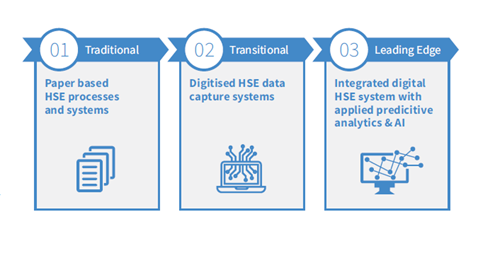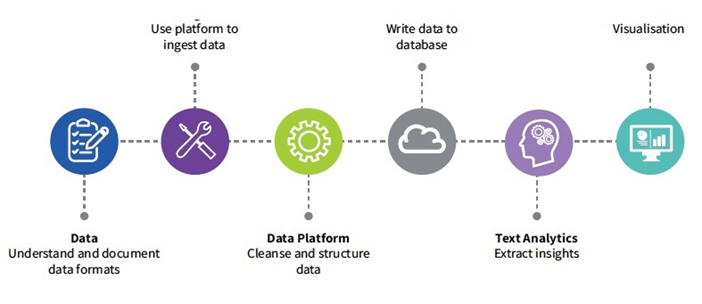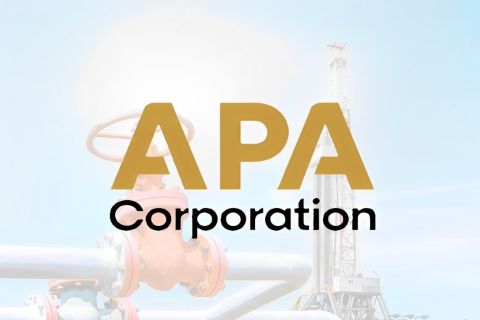Effective HSE management is more crucial than ever, especially in the high-risk, capital-intensive sectors, from oil and gas to transportation. A single HSE incident can disrupt business operations and even damage corporate reputation. The issue is less about the lack of safety data, which are ever growing in a digital age, and more about how to best use the plethora of information that is frequently gathered—applying data science and artificial intelligence (AI) pointing the way forward.
HSE reporting trends
HSE incidents were traditionally logged on paper, meaning data existed but not really in a usable format. As digital tools for managing HSE issues evolved, the profession has moved to a transitional maturity stage. In the best-case scenarios, digitized capture systems and supporting HSE procedures are applied in a structured way, giving organizations the assurance that critical risks are being recorded and better managed.
These new HSE engagement programs are generating vast amounts of disparate HSE data, all of which need to be reviewed and analyzed. What is more, the level of data is set to grow. The increasing input of employees in shaping risk assessment and management is a future pattern as organizations adopt a human-centered approach at a corporate and strategic level.
Handling all this information is proving problematic, but there are solutions ahead. Advanced technology is already emerging from unlocking fresh insights and creating new value for businesses. Before looking forward, it would be worth reflecting on the current landscape (Figure 1).

Missed opportunities
Although most companies today capture HSE incidents, many struggle to absorb and understand the data in their possession. Emerging risks and safety issues are missed. Actionable insights remain hidden. The opportunity to put in place plans to prevent HSE issues from being repeated is lost. Most organizations have too much HSE data and too little time to investigate it.
The range of datasets generated by workforce safety reports, near miss reports, permits to work, job hazard analysis, audits, inspections and observations is rarely integrated. There is no single repository to mine for HSE insights. Often the most useful information stays locked away in the free-text description of the incident, where the clues lie as to the root causes of the incident.
Without an integrated HSE source, analyzing safety data is labor intensive and highly inefficient. For these reasons, Lloyd’s Register (LR) estimates that more than 75% of company data, even when available, cannot be easily analyzed. This challenge is exacerbated by three further factors. Companies operating in high-hazard industries have HSE procedures in place, but they tend to be individual procedures, isolated from one another. This makes it extremely difficult to see the bigger picture across the organization—behaviorally, geographically and historically. Some organizations also can experience difficulties in standardizing, collecting and digitizing safety data. Thirdly, data gathering is often not targeted correctly to detect and monitor significant risks and draw out game-changing insights (Figure 2).

Organizations can use advanced technology solutions to leverage the power of their data, creating a leading-edge, predictive approach to HSE management. Rapid progress in data science, powerful computing and enhanced algorithms, including machine learning and AI, are all playing a part in this evolution.
Five leaps forward
Integrating data fully. Through digitization, organizations can seamlessly integrate separate datasets across all sorts of formats into a data lake. With integration, organizations also can draw additional insights from their existing organizational data.
Adding sensor data. Richer context, beyond traditional reporting techniques, enhances risk prediction. Sensor technology is introducing informative new images to HSE management and enabling body-condition monitoring of people, equipment and assets. These developments are helping to provide actionable and often real-time insights into HSE risks and incident management. LR has, for a while now, been testing a variety of new technologies through its innovation teams and SafetyTech Accelerator. This has produced several new partnerships between LR and providers of technology in the area of video hazard analytics, personal protective equipment monitoring, locations and vital signs monitoring.
Applying predictive analytics. Advanced data and digital tools enable the organization to identify and analyze the direct causes of incidents at scale, presenting a clearer picture of where to focus HSE efforts. Fresh insights gathered are helping to identify issues that were previously unknown and prevent safety risk incidents from happening.
Using AI. Up to 80% of accidents result from human error. However, human behavior has been hard to measure to date. AI is being used for advanced text analytics. The LR SafetyScanner, a natural language processing technology system, automatically generates categories of hazards using this approach. The results reveal previously hidden insights.
Along with text analytics, vision and vital-signs analytics also are being adopted. Human interactions and negative physical conditions, such as fatigue and heat exhaustion, can now be understood in the context of risks and incidents. A previously unobtainable detailed level of insights is helping to enhance HSE strategies and processes from a very human perspective.
Seeing data visually. New dashboard technologies are making it easier to identify, investigate and communicate key insights, informing better decision-making and building greater awareness of critical HSE issues. Introducing advanced analytics to the mix gives HSE professionals a powerful tool at their fingertips to spot emerging risks and patterns.
For many organizations, HSE management is already on a transformational path. By adding advanced data science and AI to HSE management, organizations can bring all the relevant information they need together in one place. With a single view of HSE matters, priorities can be identified and efforts focused in the right areas, reducing incident rates and providing assurance that critical HSE risks are recorded and well-managed.
Education fundamental
The adoption of technology will be critical in creating a safer workplace, but the importance humans play here should not be neglected. Internal education remains fundamental. When reporting an incident, for instance, LR asks employees to categorize the type of incident they encountered, helping the company’s specialists analyze the event. About 20% of personnel choose the “other” category, making it difficult to understand what is being reported. Even AI will struggle to make sense of ambiguous data.
_____________________________________________________________________________________
Have a story idea for Operator Solutions? This feature highlights technologies and techniques that are helping upstream operators overcome their challenges. Submit your story ideas to Group Managing Editor Jo Ann Davy at jdavy@hartenergy.com.
Recommended Reading
Gas Prices in a Summer of Discontent
2024-05-14 - In February, natural gas prices dropped below $2/MMBtu and stayed there. How is the market handling it, and when will the price pick back up?
APA Corp. Latest E&P to Bow to Weak NatGas Prices, Curtail Volumes
2024-05-07 - APA Corp. plans to curtail gas and NGL production in the U.S. owing to weak Waha prices but remains confident it can deliver in the Permian Basin, CEO John Christmann said during a quarterly webcast with analysts.
Kissler: Mideast Tension Elevates Crude Prices—But for How Long?
2024-05-09 - Producers should be aggressive in locking in desirable crude oil prices on an abnormal market strength.
US Drillers Cut Oil, Gas Rigs for Third Week in a Row
2024-05-10 - Baker Hughes said oil rigs fell three to 496 this week, their lowest since November, while gas rigs rose one to 103.
Despite Sanctions Russia Still World’s Fourth Largest LNG Exporter
2024-05-23 - Russia ranked as the world’s fourth-largest LNG exporter in 2023, sending out cargoes of 30 mtpa. Russia’s LNG capacity could surpass 74 mtpa capacity by 2030, according to details published by Flex LNG.




